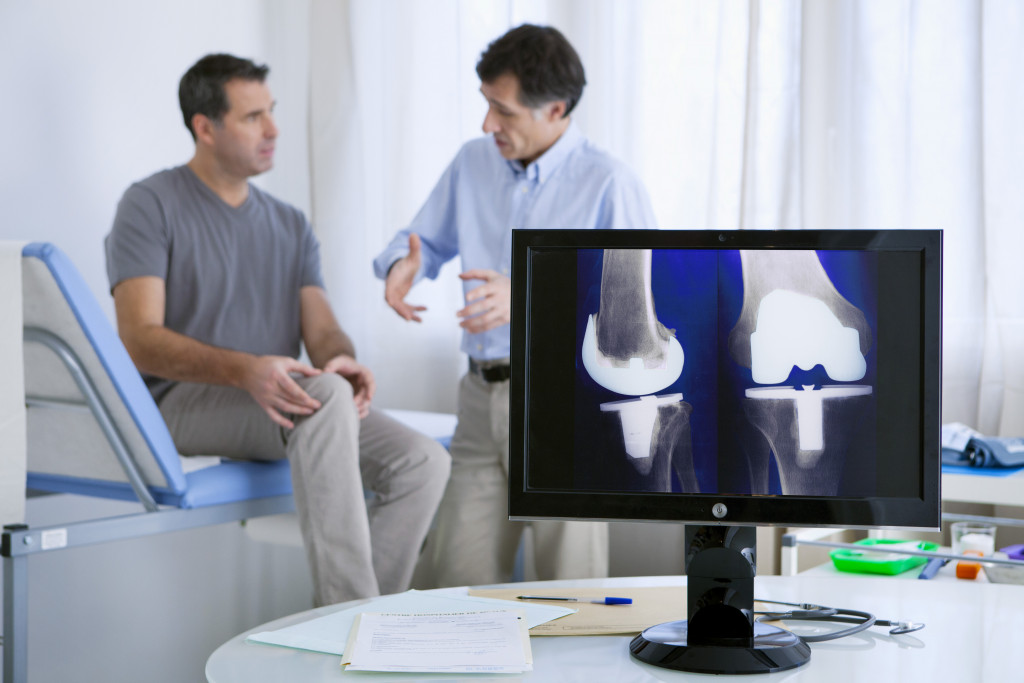Around 10 million people in the United States have osteoporosis, a disease that causes bones to become weak and brittle. Osteoporosis often doesn’t have any signs or symptoms until a bone breaks. A loss of height may be one sign. Doctors use X-rays to diagnose osteoporosis.
Fortunately, there are treatments for osteoporosis that help reduce your risk of breaking a bone.

What Is Osteoporosis?
Osteoporosis is a condition that weakens bones and makes them more likely to break. It’s most common in women after menopause, but it can happen at any age. Bone loss can occur for many reasons.
First, changes in hormones can contribute to an increased risk of osteoporosis. Take, for example, fluctuating or low estrogen levels. Estrogen is a hormone made in large quantities by the ovaries before menopause. When women go through menopause, estrogen production slows down and eventually stops. Without estrogen, bones can become weak and more likely to break.
Second, bone loss is also caused by a lack of certain nutrients like calcium and vitamin D. Calcium is essential for strong bones and teeth. Vitamin D helps the body absorb calcium and is also important for strong bones and teeth.
Third, medications may play a role in bone loss. Some medicines can increase your risk of breaking a bone such as steroids, heart and blood pressure medicines, and hormone therapy.
Your lifestyle can also influence bone loss. Smoking is harmful to bones, and lack of physical activity weakens them.
Lastly, there’s aging. Over time, your body changes and so do the cells in your bones. Minor fractures are more common with age, leading to weaker bones.
When you have osteoporosis, you have weak bones that break easily. If you don’t treat it can cause pain and disability. Fortunately there are treatments for osteoporosis that help reduce your risk of breaking a bone.
What Are the Signs of Osteoporosis?
Osteoporosis often doesn’t have any signs or symptoms until a bone breaks. A loss of height may be one sign. Doctors use X-rays to diagnose osteoporosis.
However, people with osteoporosis may experience the following:
- A broken bone without a fall or injury
- Back pain caused by compression fractures of the spine
- Loss of height for women over age 50
Diagnosis and Treatment
Doctors diagnose osteoporosis based on your medical history, family history, and a physical exam. After diagnosis, you’ll discuss treatment with your doctor. Your options may include medicines such as estrogen therapy, bisphosphonate medications, other treatments, or a combination of therapies.
Osteoporosis is not curable, and it is unfortunately a progressive disease. You also cannot reverse the damage to the bones. However, you can do many steps to minimize its impact on your health, delay the progress, and strengthen the bones.
1. Get Professional Help As Soon as Possible
You do not have to manage this condition alone. Talk with your primary care doctor or endocrinologist about getting treatment, and be sure to ask questions if you’re unsure of something. If your primary care doctor doesn’t know enough about osteoporosis, tell them you need to be referred to another healthcare provider for consultation.
If you’re living alone, consider moving into assisted living homes, where you’ll receive round-the-clock care and help with daily tasks.
2. Increase Your Physical Activity
Aerobic exercises like walking, cycling or swimming three to five times a week helps strengthen bones and prevent fractures. It also improves cardiovascular health, muscle strength, and reduces your risk of diabetes.
Muscle-strengthening activities include weightlifting or using resistance bands. These also strengthen bones and help you maintain a healthy weight to reduce the load on your spine.
Do not lift weights until your doctor gives you the go-ahead. A daily activity plan for frail people will usually involve a doctor’s referral for therapy and home visits to fit in the exercise programs.
3. Eat a Well-Balanced Diet to Get the Nutrients You Need
Eating well can also help maintain your bone health. Avoid foods high in potassium, sodium, and phosphorus because these increase blood acid levels, which leads to bone demineralization. Eat plenty of calcium-rich food, but reduce or avoid caffeine since it stimulates the kidneys to get rid of calcium.
Ensure that your doctor knows about any dietary supplements or alternative medicines you are taking to avoid interactions with medications. You should also talk to a registered dietitian to help you come up with an eating plan personalized for you.
Osteoporosis is a debilitating disease, but prompt diagnosis and treatment, as well as key prevention techniques, can delay its progress so you can still enjoy good quality of life.

